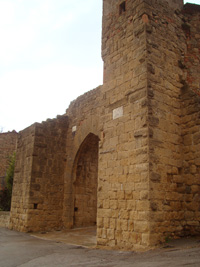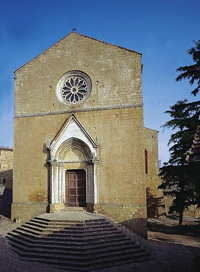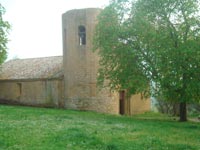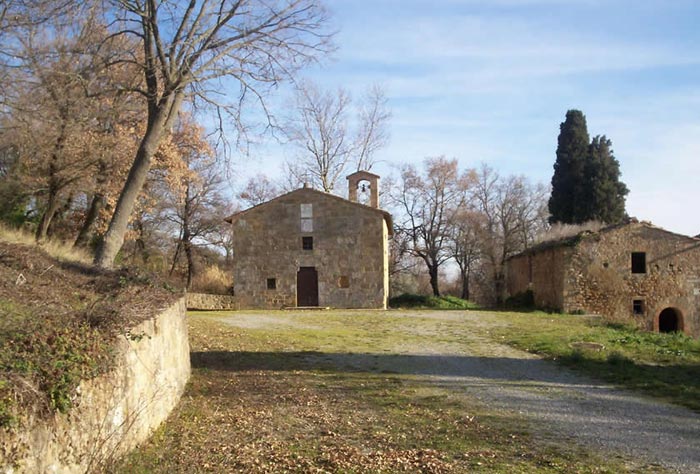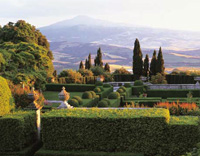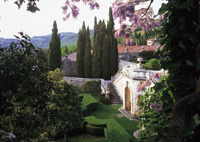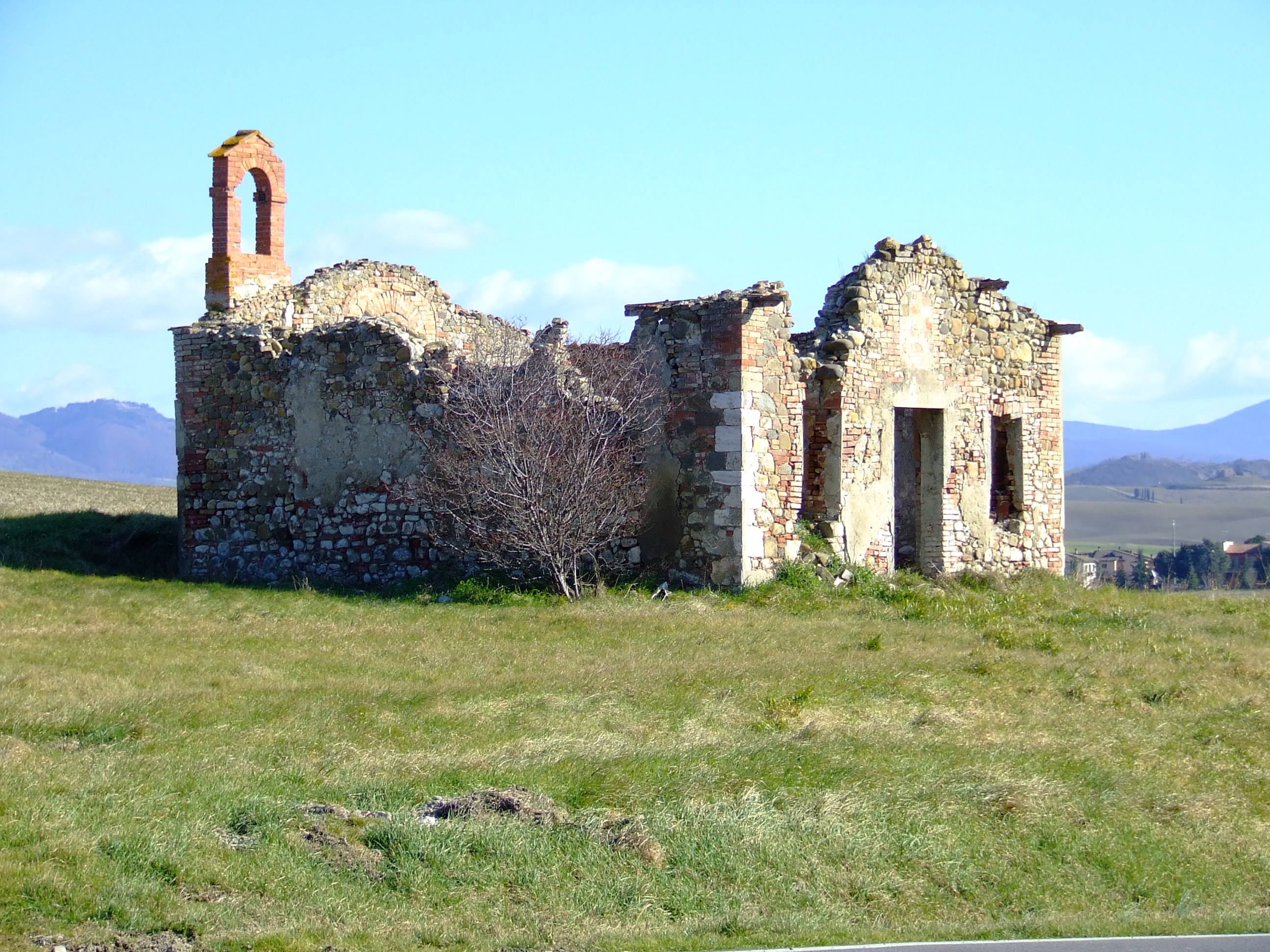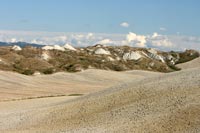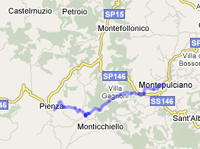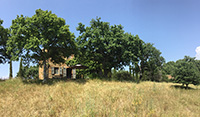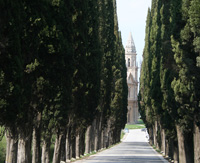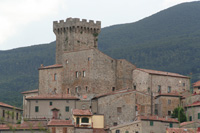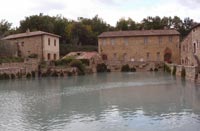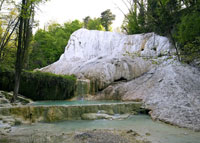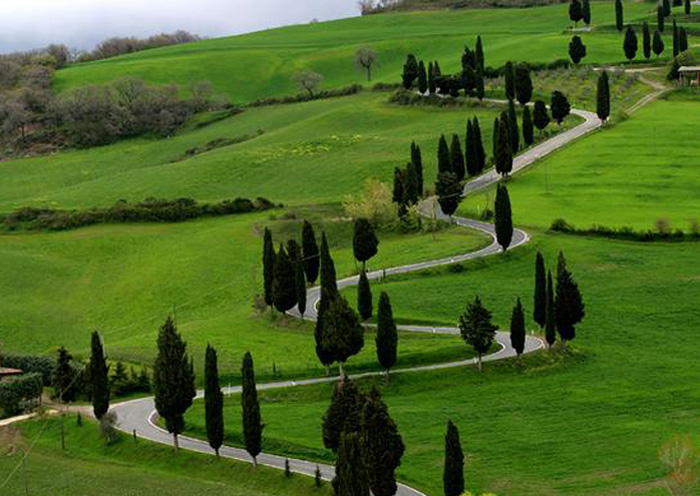 |
|
| N L I T | The famous winding road with cypresses from la Foce to Monticchiello The famous road lined with cypress is just southeast of Monticchiello, a small town south of Pienza. As you approach Monticchiello on the main road from the south, the zigzagging cypress lined road is on your right just before Monticchiello. |
Monticchiello |
Monticchiello is a small centre in the heart of the Orcia valley whose beauty derives from its geographical position and the harmonious integration of its medieval architecture. Special event is the il Teatro Povero, the Poor Theatre, a most impressive and clear sign of the town's vitality. Every year a new production, written, conceived and directed by the people of Monticchiello' returns to speak of past, present and future events of this community. Villa La Foce, between
Montepulciano and Pienza, is located near the site of an Etruscan settlement and a burial-place dating from the 7th century BC. The harmony between this garden and the surrounding nature makes la Foce an ideal example of Tuscany’s architectural and cultural evolution in the 20th century. The Villa itself was built in the late 15th century as a hostel for pilgrims and merchants traveling on the via Francigena. In 1924 the property was bought by Antonio Origo and his wife Iris.
The gardens and estate of La Foce constitute one of the most important and best kept early twentieth-century gardens in Italy.
[2] Restaurants Monticchiello Osteria La Porta | Via del Piano 1, 53026 Monticchiello | www.osterialaporta.it |
||||
|
Photo gallery Monticchiello
|
||||
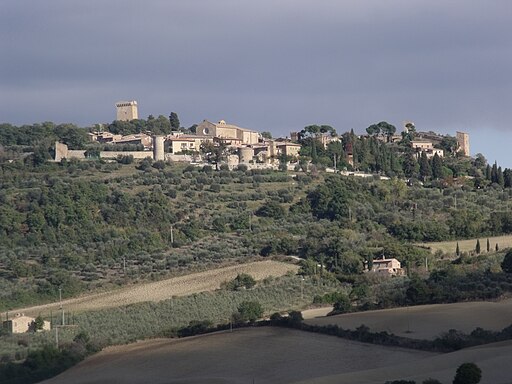 |
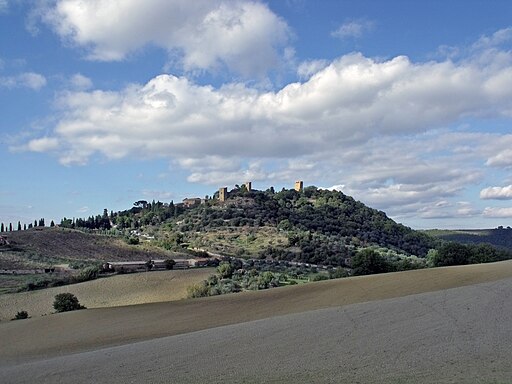 |
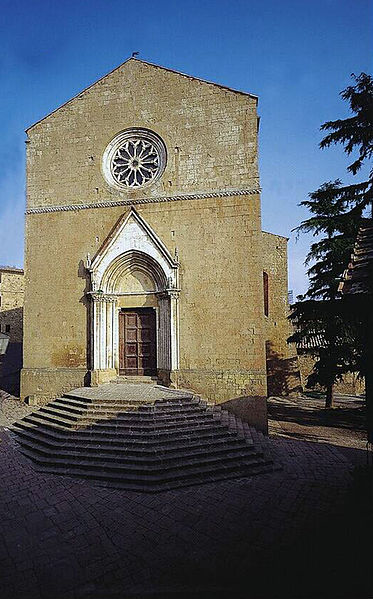 |
||
Monticchiello, panorama
|
Monticchiello, panorama | Pieve dei Santi Leonardo e Cristoforo a Monticchiello
|
||
 |
 |
 |
||
Monticchiello,Torre del Cassero
|
Mura di Monticchiello, visto da sud-est, Monticchiello (frazione di Pienza)
|
Monticchiello, Porta Sant Agata | ||
| Pienza | ||||
It was Pienza that Renaissance town-planning concepts were first put into practice after Pope Pius II decided, in 1459, to transform the look of his birthplace. |
||||
| The monastery of Sant'Anna in Camprena was founded in 1332-1334 by Bernardo Tolomei as a hermitage for the Benedictines; it was remade in the late 15th-early 16th century, and several times in the following centuries. The refectory houses frescoes by il Sodoma (1502–1503). The monastery of Sant'Anna in Camprena was founded in 132-1334 by Bernardo Tolomei as a hermitage for the Benedictines. Bernardo Tolomei was the founder of the Roman Catholic Congregation of the Blessed Virgin of Monte Oliveto. The monastery was remade in the late 15th-early 16th century, and several times in the following centuries. One can recognize this spot as the refuge of The English Patient, a serene Romanesque compound with a Renaissance chapel that houses a fresco by Pinturicchio. In the refectory there is a beautiful cycle of frescoes. dating from 1503-1504, depicted on the back wall. The Multiplication of the Loaves and Fishes. On the entrance wall three scenes with an enthroned S. Benedict surrounded by monks, the Pietà, the Madonna with Child, S. Anna and two Olivetan monks. All are the works of Antonio Bazzi, called Sodoma, a brilliant Piemontese artist (Vercelli 1477-Siena 1549). Accademia delle Crete Senesi is Philippe Herreweghe’s Festival in Tuscany. The concerts of the “Accademia delle Crete” take place in small but marvellous churches, among them Sant'Anna, chosen because of their adequate acoustics for the repertoire on the program. A road south from Pienza, providing the best view of the garden façade of Palazzo Piccolomini and the great apse of the Duomo, leads to Monticchiello. |
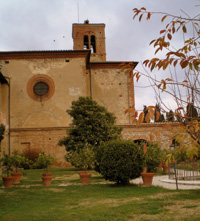 Sant’Anna in Camprena |
|||
The medieval castle of Castelluccio (literally little castle) lies on the summit of a hill on the La Foce estate. Each summer, the cultural association La Tartaruga organizes art shows at the medieval castle Castelluccio. The curator, Plinio de Martiis (known for his important gallery in Rome) has in recent years brought the work of renowned artists such as Kounellis and Manzoni to Castelluccio, as well as promoting young, less famous artists. The Pieve di Santa Maria dello Spino, between Monticchiello and Bagno Vignoni, is used on the annual Corpus Domini procession, the Processione del Corpus Domini. The church of Santa Maria dello Spino, which nowadays belongs to the Gonzi family and lies just 2 km. from Le Fontanelle, is one of the most important little churches of the Val d'Orcia. |
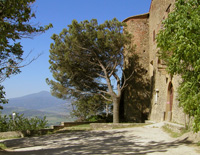 Castelluccio di Pienza |
|||
Pieve di Santa Maria dello Spino
|
||||
The Castello di Spedaletto, situated half way between Bagno Vignoni and Monticchiello, was built in the 12th century by the monk Ugolino da Rocchione, to host the pilgrims and wayfarers who travelled the old Via Francigena, one of the most important roads in Europe in the Middle Ages. Already in the year 1200 the castle was administrated by the Spedale di Santa Maria della Scala and had surely the function of a fortified farm as well as hostel for the pilgrims. In the Middle of 15th century the castle was restored and got additional fortifications.
|
||||
Villa La Foce, a fabulous villa with famous garden Villa La Foce, was created by Iris Origo and Cecil Pinsent. Pinsent worked from 1927 onwards at La Foce, developing a romantic garden around a villa that had originally been a pilgrim hospice on the via Francigena.
|
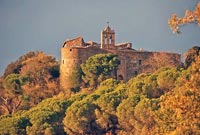 Castelluccio Bifolchi |
|||
Moonlight in Maremma at @podersantapia, a splendid location in the heart of the Tuscan Maremma
|
||||
Monticchiello and Villa La Foce are within an hour's drive from Podere Santa Pia.> |
||||
View Larger Map |
||||
Restaurants Osteria La Porta | Via del Piano 1, 53026 Monticchiello | www.osterialaporta.it |
||||
Even now I miss Italy dearly, I dream about it every night – Eila Hiltunen
|
||||
[1] Eila Hiltunen The sculptor Eila Hiltunen was born on November 22, 1922, in Sortavala, Eastern Finland The life and career of Eila Hiltunen, who has significantly influenced the history of Finnish art, is rich. Links |
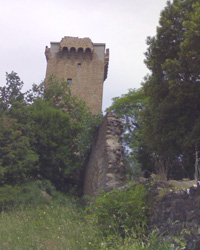 Monticchiello, Torre del Cassero |
|||
| [2] Iris Origo (1902-1988), the Marchesa Origo, was an Anglo-Irish-American writer, who devoted much of her life to the improvement of the Tuscan estate at La Foce, near Montepulciano, that she purchased with her husband in 1924. Iris Margaret Cutting was born on 15 August 1902, the daughter of William Bayard Cutting, the son of a rich and philanthropic New York family and Sybil Cuffe. Her parents travelled widely after their marriage, particularly in Italy. Following the early death of Bayard Cutting in 1910, Sybil Cuffe settled with her daughter Iris in Italy, buying the Villa Medici in Fiesole, one of Florence’s most spectacular villas. In 1918, Iris’s mother married the architectural historian Geoffrey Scott, who later embarked on a relationship with Vita Sackville-West. The marriage was to last until 1927; following their divorce, she was to marry for a third time, to the essayist Percy Lubbock. She died in 1943. Selected Works by Iris Origo Links |
||||
[3] The activity of the Teatro Povero has roots in Monticchiello which go back earlier than the date of its formal beginnings. Various evidence shows that theatre has been an important component of the life and history of this village over a long period.
|
||||
|
|
||||
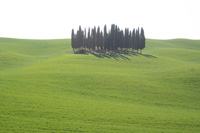 |
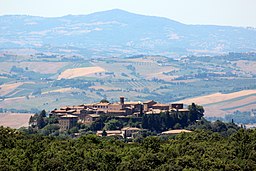 |
|||
| Cipressi tra San Quirico d'Orcia e Montalcino | Sant'Angelo in Colle | Val d'Orcia album
|
||
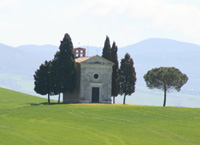 |
 |
|||
Cappella della Madonna di Vitaleta, nei pressi di San Quirico d'Orcia
|
Pienza | Gallina, chiesa di La Scala
|
||
| Riserva Naturale Lucciola Bella |
||||
The Nature Riserve Riserva Naturale Lucciola Bella is situated south east of Pienza and Montichiello, in the Val d’Orcia, which stretches up to Chianciano Terme. The riserve is in a small corner of the typical landscape of the crete senesi.
|
||||
Walking in the Val d'Orcia |
||||
The walk takes off at Piazza Dante Alighieri, through the Viale S. Caterina, direction Pieve di Corsignano. Map |
||||
| From Montepulciano to Pienza | 11 km, 3 hours |
||||
A gentle up & downhill walk from the magnificent town Montepulciano to the perfect place Pienza along the beautiful scenery of Toscany. The walk starts at the Piazza Grande, next to the Duomo. |
||||
Walking in the Val d'Orcia | 7 best walks around Pienza
|
||||
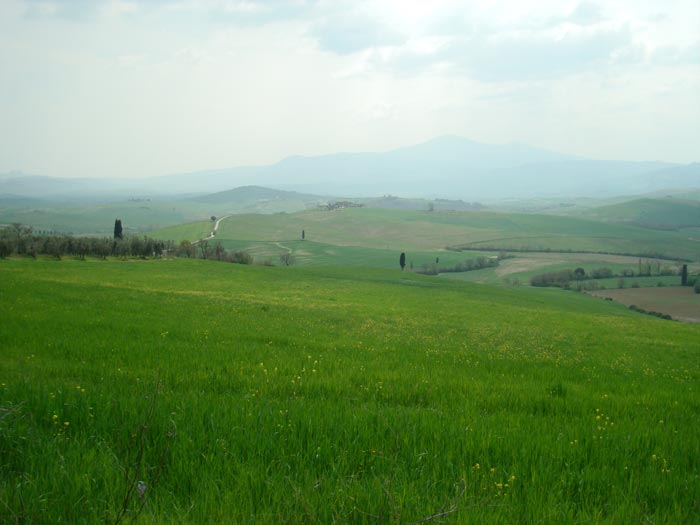 |
||||
Trekking in the Val d'Orcia, stunning landscapes between Monticchiello and Pienza |
||||
Pienza - Monticchiello | 5 km |
||||
From Monticchiello to Pienza you walk on the balcony of Val d'Orcia, a valley among beautiful rolling hills, framed by wheat fields, and occasional dark green pinnacles of cypress. Walk Pienza - Monticchiello | 7 km |
||||
Maps: Multigraphic Val d'Orcia, Kompass nr. 662 Lago trasimeno and Kompass nr. 653 Pienza-Montalcino-Monte Amiata. |
||||
Tuscany's Best-Kept Secret | Podere Santa Pia
|
||||
Podere Santa Pia |
Podere Santa Pia |
|||
Montepulciano |
Arcidosso |
Val d'Orcia" between Montalcino, Pienza and San Quirico d’Orcia. |
||
| The Val d'Orcia | ||||
South of San Quirico, approached from by-roads on either side of the Via Cassia, is the Val d'Orcia, the beautiful valley of the Orcia river. West of the Cassia are well-preserved villages, castles and thermal baths in the foothills of Monte Amiata, while to the east the valley widens out on either side of the river with a landscape of eroded clay slopes and small sharp ridges known as calanchi , much of it part of the huge estate of La Foce. Just south of San Quirico, reached through beautiful countryside, is the tiny village of Vignoni, from which there is a fine view. It has a truncated medieval tower, and a 15C palace on the main street which leads to the Romanesque church on the edge of the hill. The road continues to climb towards Ripa d'Orcia, a castle surrounded by ramparts in a spectacular, isolated position overlooking the Orcia Valley (it is now a hotel residence, 0577 530 23). Bagno Vignoni is a tiny medieval spa on a small plateau. The hot water spring, known since Roman times, bubbles up into a large piscina, constructed by the Medici, in the charming and perfectly preserved piazza. It forms one of the most unusual and evocative sights in Tuscany, especially in winter when the condensation from the hot spring water creates a mist. Castliglione d'Orcia (540m) is another picturesque little village, built round a ruined castle. The main piazza, named after the 15C artist Vecchietta, traditionally believed to have been born here, preserves its old paving of brick and pebbles and there is a well in the centre, dated 1618. The pieve of Santi Stefano e Degna, a Romanesque church with a Renaissance façade, has a Madonna enthroned with four Saints by Giovanni di Bartolomeo (1531), a large Crucifixion by Fabrizio Boschi and two early 16C frescoed lunettes. The pretty borgo has narrow streets with some medieval houses and a little Romanesque church, the Chiesa delle Sante Marie. There is a fine view over the Orcia valley. Nearby is Rocca d'Orcia a particularly well-preserved medieval village on a slope, dominated by its spectacular castle, the Rocca di Tentennano where exhibitions are held (open in summer, 10.00-13.00, 15.30-19.30, in winter at weekends, reduced hours). The piazza has a large octagonal stone well in the centre. The parish church of San Simeone preserves a fresco of the Madonna of Mercy by a follower of Bartolo di Fredi and a Madonna of the Rosary by Francesco Rustici. Farther south is Campiglia d'Orcia in an elevated position (811m) on the north slope of Monte Amiata, facing Radicofani. It has picturesque medieval streets and a tall bell-tower built on a rocky spur. In the church of San Biagio is a Madonna and Child with Saints attributed to Sebastiano Folli. |
||||
| Dal Vivo d'Orcia all'Eremo e all'Ermicciolo fino alle sorgenti del Vivo |
||||
| PUNTO DI PARTENZA E ARRIVO: Vivo d’Orcia (sentiero circolare). LUNGHEZZA: 10 Km circa. DURATA: 3 ore circa. |
||||
| L’escursione inizia dall’ufficio postale nel centro di Vivo d’Orcia. Seguire l’indicazione “Contea del Vivo/Eremo” e percorrere la “Via Amiata” che diventa “Via dell’Eremo” e che conduce fuori dal paese. La strada asfaltata finisce in una abetina e immediatamente ci si trova presso un ponte di pietra molto romantico (a sinistra). Attraversare il ponte e quindi il torrente del Vivo e raggiungere la “Contea del Vivo”. Sulla destra si erge l’imponente castello “Contea” della famiglia Cervini, ad oggi ancora abitato dalla famiglia stessa. (Nel corso della passeggiata si può ancora notare, da una certa distanza, una costruzione del tardo medioevo). Passare sotto l’arco e raggiungere il meraviglioso borgo dell’Eremo. Prima della chiesa girare a sinistra attraversando la fila di case e proseguire su un sentiero di rena che conduce fuori dal piccolo Borgo. Al primo bivio prendere la strada a destra. (Eventualmente se il recinto è chiuso, lo si può aprire per passare). Fino ai mesi estivi, qui sul sentiero si intersecano due o tre ruscelli. La strada è in salita e dopo circa 40 minuti si giunge a una strada a sterro. Qui girare a sinistra e proseguire per un breve tratto fino a raggiungere la strada asfaltata (SP 129). Attraversare la strada e prendere il sentiero, che va su nel bosco, tra le indicazioni per Vivo d’Orcia/Abbadia San Salvatore e il segnale di confine delle province di Siena e Grosseto. (Qui inizia una salita di circa 40 minuti). Al bivio tenersi sulla destra e camminare lungo il confine delle province. (Per orientarsi servirsi dell’insegna ATC dell’autorità preposta alla caccia delle province di Siena e Grosseto). All’incrocio seguente dopo circa 20 metri, di fronte a un frammento di roccia che si trova sulla destra del sentiero, andare in alto a sinistra. (Il punto di questo incrocio non è molto chiaro da riconoscere perchè ...FINO ALLA SORGENTE DEL VIVO l’indicazione potrebbe essere coperta da cespugli e ramoscelli!) La strada si biforca ancora una volta e bisogna tenersi sulla sinistra (notare i segni rossi e bianchi su un faggio). La salita finisce definitivamente in un’ ampia strada sterrata, sulla quale si prosegue verso sinistra. (...) [Fonte: www.amiataturismo.it] |
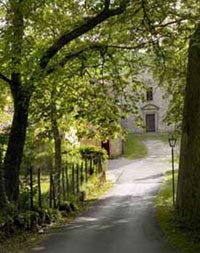 Borgo dell'Eremo e la Chiesa di San Marcello |
|||
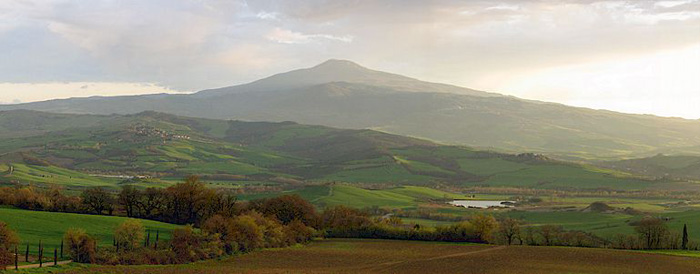 |
||||
Monte Amiata and the Val d'Orcia, view from La Foce |
||||
| The Val d’Orcia extends from the hills south of Siena to Monte Amiata. It is characterised by gentle, carefully cultivated hills occasionally broken by gullies and by picturesque towns and villages such as Pienza , Radicofani (home to the notorious brigand-hero Ghino di Tacco) and Montalcino (the Brunello di Montalcino is counted among the most prestigious of Italian wines). It is a landscape which has become familiar through its depiction in works of art from the Renaissance painting to the modern photograph. In 2004 the Val d’Orcia was added to the UNESCO list of World Heritage Sites. | ||||

